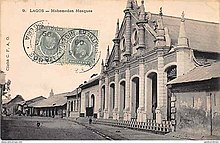Shitta-Bey Mosque
| Shitta-Bey Mosque | |
|---|---|
 | |
| Religion | |
| Affiliation | Islam |
| Status | Active |
| Location | |
| Location | Lagos Island, Lagos |
| Country | Nigeria |
| Architecture | |
| Architect(s) | João Baptista da Costa |
| Type | Mosque |
| Style | Afro-Brazilian Architecture |
| Founder | Mohammed Shitta Bey |
| Date established | July 4, 1894 |
| Groundbreaking | 1881 |
| Completed | February 7, 1892 |
| Construction cost | £3000[1][2] |
| Specifications | |
| Capacity | 200 |
| Minaret(s) | 1 |
| Materials | concrete, granite and marble |
| Designated as NHL | National Monument[3] |
| Some sources reported £5,000[4] and £7000.[5] | |
Shitta-Bey Mosque is a mosque, religious learning centre and one of the oldest mosques in Nigeria.[6] The mosque is located at Martins Ereko Street, Lagos Island, Lagos, Nigeria. It was established in 1892 and designated as National monument by Nigerian Commission for Museums and Monuments in 2013.[3] The mosque, considered one of the most important historical legacies of Nigeria,[7] Shitta-Bey Mosque was named after its founder Sierra Leonean-born Nigerian, Mohammed Shitta Bey, who was an aristocrat, philanthropist and businessman.[8]
History
[edit]The construction of the mosque started in 1891 and was financed by Mohammed Shitta Bey, a businessman and philanthropist, son of Sierra Leone-born parents of Yoruba descent. A Brazilian architect João Baptista da Costa oversaw the construction which was done with tile-work depicting the Afro-Brazilian architecture.[3] The Shitta-Bey Mosque launched on July 4, 1894, at a ceremony presided over by Governor of Lagos, Sir Gilbert Carter. Others in attendance included Oba Oyekan I, Edward Wilmot Blyden, Abdullah Quilliam (who represented Sultan Abdul Hamid II of the Ottoman Empire), and prominent Lagosian Christians such as James Pinson Labulo Davies, John Otunba Payne, and Richard Beale Blaize as well as foreign representatives.[7] Quilliam brought a letter accredited to the Sultan of Turkey asking Lagos Muslims to embrace Western education.[9]
It was at the launch that Mohammed Shitta was honored with the "Bey" title, the Ottoman Order of Medjidie 3rd class (the highest class for a civilian) by Sultan Abdul Hamid II. Thereafter, Mohammed Shitta became known by the compounded name Shitta-Bey.[10][11]
Bibliography
[edit]- Ostien, Philip; Makinde, Abdul-Fatah 'Kola (2012-01-01). "Legal Pluralism in Colonial Lagos: The 1894 Petition of the Lagos Muslims to their British Colonial Masters". Die Welt des Islams. 52 (1): 51–68. doi:10.1163/157006012X627904. ISSN 1570-0607.
References
[edit]- ^ "Shitta Bey Mosque". City Seeker. Retrieved 19 October 2017.
- ^ Fasinro, Hassan Adisa Babatunde. Political and cultural perspectives of Lagos. University of Michigan. p. 188.
- ^ a b c "Shitta Bey Mosque: Visiting a historic masterpiece". Daily Trust. Retrieved 19 October 2017.
- ^ "121-year-old Shitta-Bey mosque, Nigeria". Masjed, Iran. Retrieved 19 October 2017.
- ^ Geaves, Ron. Islam in Victorian Britain: The Life and Times of Abdullah Quilliam. Kube Publishing Ltd, 2010. p. 75. ISBN 9781847740380. Retrieved 19 October 2017.
- ^ Nurudeen, Nahimah Ajikanle (Oct 23, 2015). "Shitta Bey Mosque: Visiting a historic masterpiece". Daily Trust Newspapers. Daily Trust Newspapers. Daily Trust. Retrieved 29 January 2018.
- ^ a b "Nigeria's Turkish mosque, the trust of Sultan Abdülhamid II". Dailysabah.com. Daily Sabah. Retrieved 20 December 2018.
- ^ "Shitta-Bey Mosque – Isale Eko". Retrieved 2023-10-08.
- ^ Ostien & Makinde 2012, p. 59.
- ^ Singleton, Brent D. "That Ye May Know Each Other: Late Victorian Interactions between British and West African Muslims". California State University, San Bernardino CSUSB ScholarWorks. Library Faculty Publications. p. 8. Retrieved 19 December 2016.
- ^ Adam, H.L. The Wide World Magazine: An Illustrated Monthly of True Narrative, Adventure, Travel, Customs, and Sport, Volume 17. G. Newness, 1906. pp. 221–227. Retrieved 19 December 2016.
